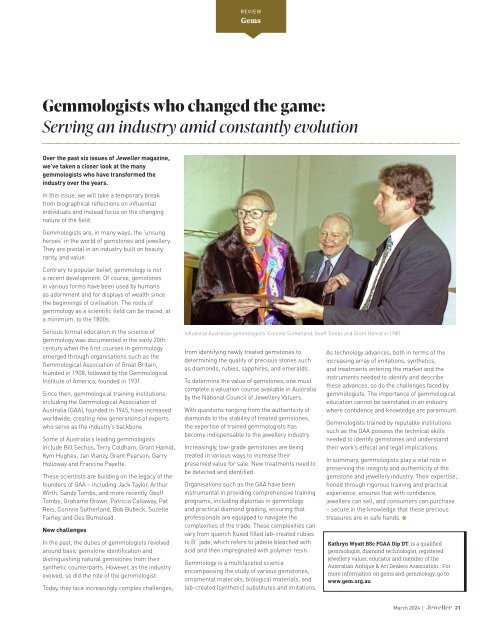Jeweller - March 2024
Create successful ePaper yourself
Turn your PDF publications into a flip-book with our unique Google optimized e-Paper software.
REVIEW<br />
Gems<br />
Gemmologists who changed the game:<br />
Serving an industry amid constantly evolution<br />
Over the past six issues of <strong>Jeweller</strong> magazine,<br />
we’ve taken a closer look at the many<br />
gemmologists who have transformed the<br />
industry over the years.<br />
In this issue, we will take a temporary break<br />
from biographical reflections on influential<br />
individuals and instead focus on the changing<br />
nature of the field.<br />
Gemmologists are, in many ways, the ‘unsung<br />
heroes’ in the world of gemstones and jewellery.<br />
They are pivotal in an industry built on beauty,<br />
rarity, and value.<br />
Contrary to popular belief, gemmology is not<br />
a recent development. Of course, gemstones<br />
in various forms have been used by humans<br />
as adornment and for displays of wealth since<br />
the beginnings of civilisation. The roots of<br />
gemmology as a scientific field can be traced, at<br />
a minimum, to the 1800s.<br />
Serious formal education in the science of<br />
gemmology was documented in the early 20th<br />
century when the first courses in gemmology<br />
emerged through organisations such as the<br />
Gemmological Association of Great Britain,<br />
founded in 1908, followed by the Gemmological<br />
Institute of America, founded in 1931.<br />
Since then, gemmological training institutions,<br />
including the Gemmological Association of<br />
Australia (GAA), founded in 1945, have increased<br />
worldwide, creating new generations of experts<br />
who serve as the industry’s backbone.<br />
Some of Australia’s leading gemmologists<br />
include Bill Sechos, Terry Coldham, Grant Hamid,<br />
Kym Hughes, Jan Vlanzy, Grant Pearson, Garry<br />
Holloway and Francine Payette.<br />
These scientists are building on the legacy of the<br />
founders of GAA – including Jack Taylor, Arthur<br />
Wirth, Sandy Tombs, and more recently, Geoff<br />
Tombs, Grahame Brown, Patricia Callaway, Pat<br />
Reis, Corinne Sutherland, Bob Bubeck, Suzette<br />
Fairley, and Des Bumstead.<br />
New challenges<br />
In the past, the duties of gemmologists revolved<br />
around basic gemstone identification and<br />
distinguishing natural gemstones from their<br />
synthetic counterparts. However, as the industry<br />
evolved, so did the role of the gemmologist.<br />
Today, they face increasingly complex challenges,<br />
Influential Australian gemmologists: Corinne Sutherland, Geoff Tombs and Grant Hamid in 1980.<br />
from identifying newly treated gemstones to<br />
determining the quality of precious stones such<br />
as diamonds, rubies, sapphires, and emeralds.<br />
To determine the value of gemstones, one must<br />
complete a valuation course available in Australia<br />
by the National Council of <strong>Jeweller</strong>y Valuers.<br />
With questions ranging from the authenticity of<br />
diamonds to the stability of treated gemstones,<br />
the expertise of trained gemmologists has<br />
become indispensable to the jewellery industry.<br />
Increasingly, low-grade gemstones are being<br />
treated in various ways to increase their<br />
preserved value for sale. New treatments need to<br />
be detected and identified.<br />
Organisations such as the GAA have been<br />
instrumental in providing comprehensive training<br />
programs, including diplomas in gemmology<br />
and practical diamond grading, ensuring that<br />
professionals are equipped to navigate the<br />
complexities of the trade. These complexities can<br />
vary from quench fluxed filled lab-created rubies<br />
to B” jade, which refers to jadeite bleached with<br />
acid and then impregnated with polymer resin.<br />
Gemmology is a multifaceted science<br />
encompassing the study of various gemstones,<br />
ornamental materials, biological materials, and<br />
lab-created (synthetic) substitutes and imitations.<br />
As technology advances, both in terms of the<br />
increasing array of imitations, synthetics,<br />
and treatments entering the market and the<br />
instruments needed to identify and describe<br />
these advances, so do the challenges faced by<br />
gemmologists. The importance of gemmological<br />
education cannot be overstated in an industry<br />
where confidence and knowledge are paramount.<br />
Gemmologists trained by reputable institutions<br />
such as the GAA possess the technical skills<br />
needed to identify gemstones and understand<br />
their work’s ethical and legal implications.<br />
In summary, gemmologists play a vital role in<br />
preserving the integrity and authenticity of the<br />
gemstone and jewellery industry. Their expertise,<br />
honed through rigorous training and practical<br />
experience, ensures that with confidence,<br />
jewellers can sell, and consumers can purchase<br />
– secure in the knowledge that these precious<br />
treasures are in safe hands.<br />
Kathryn Wyatt BSc FGAA Dip DT, is a qualified<br />
gemmologist, diamond technologist, registered<br />
jewellery valuer, educator and member of the<br />
Australian Antique & Art Dealers Association. For<br />
more information on gems and gemmology, go to<br />
www.gem.org.au<br />
<strong>March</strong> <strong>2024</strong> | 31

















